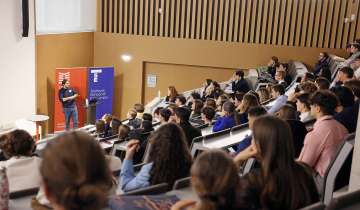Simon FUCHS soutiendra sa thèse de doctorat en sciences économiques le mardi 12 juin à 12h00, Salle MQ-212 (Manufacture des Tabacs) sur le sujet « Essays on Globalization : Historical and Contemporary Evidence »
Directeur de thèse: Thomas CHANEY chercheur associé TSE et Professeur, Sciences Po Paris.
Le jury sera composé de :
- Treb ALLEN, Professeur, Dartmouth
- Thierry Mayer, Professeur, Sciences Po
- Christian HELWIG, Professeur, TSE
- Thomas CHANEY, membre associé TSE et professeur Sciences Po
Résumé (en anglais)
This thesis contains three essays on globalization with a special focus on historical and contemporary empirical evidence and labor market effects.
In the first chapter, I study to what extent labor market frictions limit the gains from market integration. I use an external demand shock to the Spanish economy as a natural experiment to identify and quantify the effect of labor mobility costs on Spain’s development. Using newly digitized trade and labor market data, I show that during WWI (1914-1918) a large, temporary and sectorally heterogeneous demand shock emanated from belligerent countries, as a result of which Spain expanded its manufacturing employment and exports, while income growth between the north and south in Spain diverged. To quantify and analyse the role of mobility costs I build and estimate a multi-sector economic geography model that allows for sectoral and spatial mobility costs. Spatial mobility costs dominated with an estimated 80% of reallocation of labor taking place within rather than between provinces. I use the estimated model to calculate counterfactuals to examine the effects of and interaction between output and input market integration: Comparing to the non-shock counterfactual I find that the WWI-shock increased manufacturing employment by 10%, and induced highly uneven spatial development with the north growing 27% faster. The shock constituted a 6% increase in market size and increased aggregate real incomes by 20%. Lowering mobility costs by 10% increases real income gains from the WWI-shock by an additional 3%, and exceeds gains in the non-shock scenario, suggesting that labor market integration and output market integration are complements.
In the second chapter, François de Soyres and I introduce a new framework to evaluate the effects of regional diversification. We observe that in the presence of mobility frictions workers are exposed to local shocks and that in a multi-sectoral framework this induces a trade-off: Regions can specialize in their comparative advantage industries, but at the same time such specialization increases labor market risk due to sector specific shocks. If mobility costs are high, then welfare effects from lack of diversification can be substantial. We measure the segmentation of the French labor market and introduce a new spatial equilibrium model that incorporates labor market frictions, unemployment, and mobility cost into an otherwise standard multi-sector economic geography model. We employ the model to simulate unemployment responses to sector specific shock and demonstrate the interaction between mobility frictions and matching frictions.
In the third chapter, Konrad Adler and I ask the question to what extent is the set of products that are available to a country driven by the composition of international markets? We develop a quantitative framework to determine and map the similarity between countries from observed market shares of identical products across markets. We apply our framework to the global movies market where we can abstract from price competition and observe identical products and their market shares across countries. As an application we evaluate the hypothesis that the observed large increase in the revenue share of sequels has been due to shifts in the composition of global demand away from traditional western markets inducing demand risk and with sequels providing insurance. While we find substantial shifts in the profit space and lower risk associated with sequels, our simulations suggest that the risk due to taste heterogeneity in the movies market is quantitatively insufficient to explain the increase in the revenue of sequels, suggesting that other forces such as scale economies might be at play.



